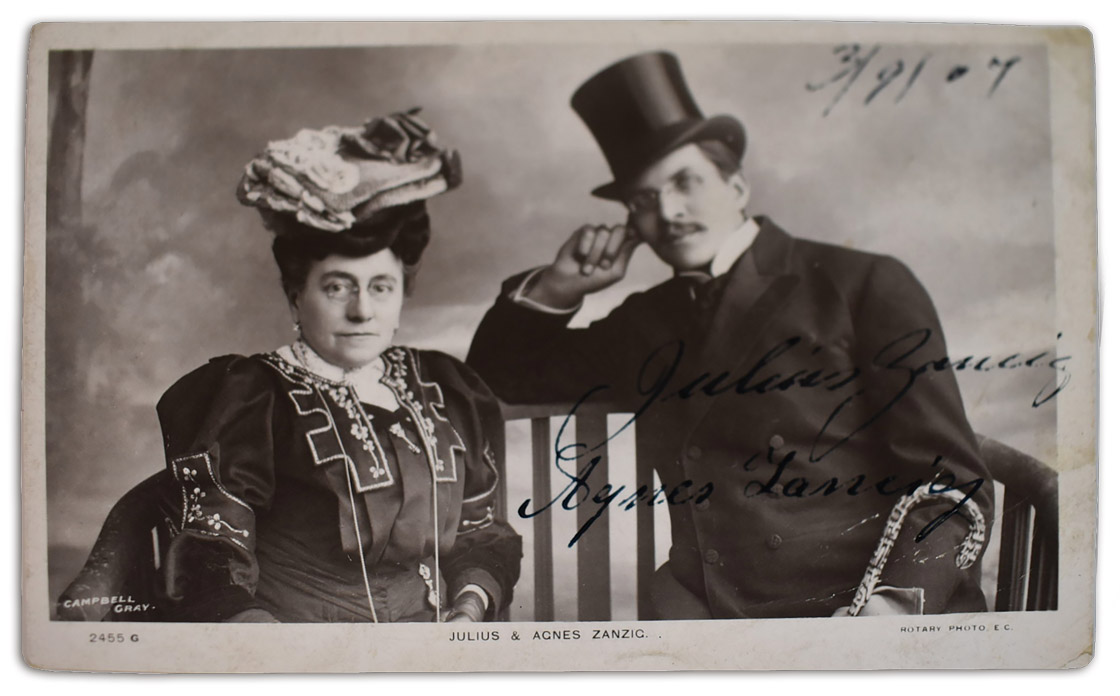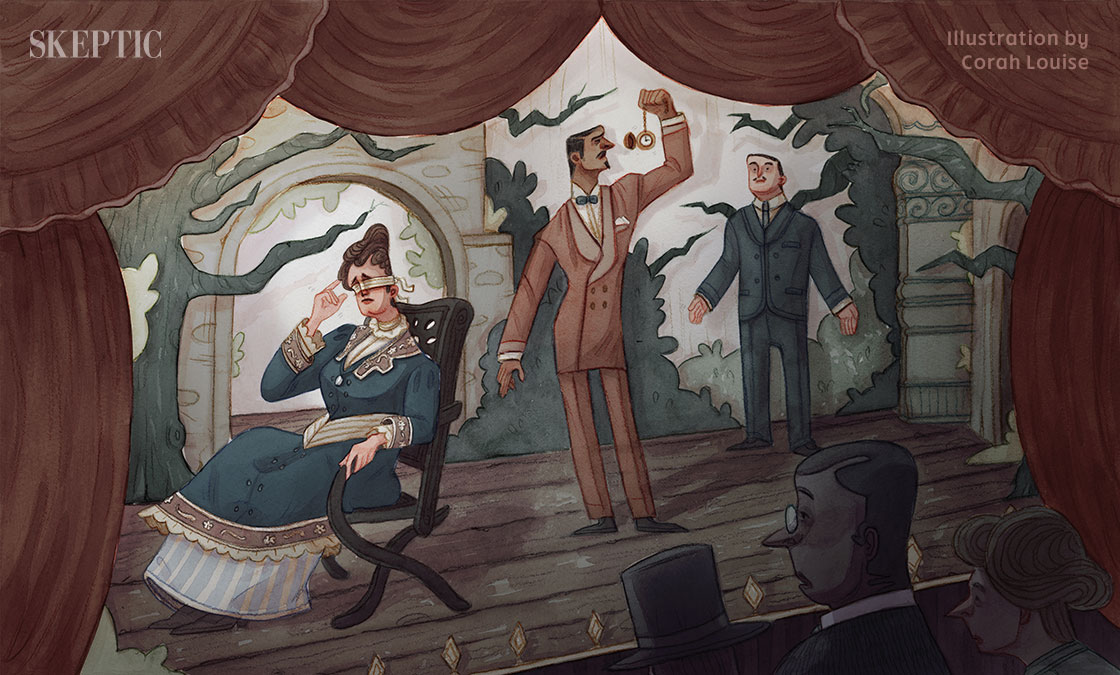How can people appear telepathic, and what is the history of duos demonstrating this type of mindreading as entertainment?
Two-person theatrical mindreading acts have been popular in the U.S. and Europe since the mid-1800s, with even earlier roots. In the most common form of this telepathy act, small objects shown to one partner roaming in the audience are correctly identified by the second performer, who is blindfolded and on stage, with no apparent communication between them.
The history of these acts is discussed most thoroughly in the groundbreaking book A First Look at Second Sight by Bob Loomis, in which he also scatters advice to would-be performers throughout. Cues: Variations on the Second Sight Act by Leo Behnke sketches some leading performers’ careers (including more recent ones), but most of the book is about how to perform such an act. The words in these titles reflect their respective subjects: “Second Sight” was an earlier common name for the two-person telepathy performance (also known as “clairvoyance”), while the use of secret “cues” from one performer to the other has been the most frequently (and clandestinely) employed method to accomplish this illusion.
A crude variant of the telepathy trick was revealed in the earliest book to substantively discuss magic tricks in English, The Discoverie of Witchcraft in 1584. Two-person mindreading was occasionally performed by magicians over the next two and a half centuries but only became common among stage magicians with the successful 1840s show of the highly influential magician Jean Eugene Robert-Houdin (from whom Houdini took his stage name), and specialists are mostly a somewhat later development. In the early 20th century, the most famous performers of such an act were the husband-and-wife duo, The Zancigs. Both Behnke and Loomis agree that the Zancigs presentation of the act was superior to all others. The Sharrocks and Mercedes both had repeat bookings at the prestigious Palace Theater in New York, Eddie Fields and his partner had a long and successful career (mostly in department stores), while The Roberts were booked regularly and for high fees for decades in theaters and nightclubs.
In total, more than a hundred successful teams are profiled in detail, and a few dozen more are listed in Loomis’s A First Look at Second Sight, while Behnke’s Cues provides much shorter entries on half as many. Most acts consisted of a man and a woman, but a man and a boy were common in the earlier years, and other variations have appeared. Even some mind-reading animal acts are profiled by Loomis, with many more listed in an appendix.
These acts were most commonly called “second sight” in the 19th century and “telepathy” or “clairvoyance” more recently. The fundamental technique utilized is the secret communication of information from the performer in the audience to their partner on stage. Although Behnke and Loomis both give examples of electronics being secretly used to accomplish this, the authors agree that (even at its peak) electronics were usually only a supplement to other techniques. By far, the most common clandestine method was the use of elaborate spoken codes or a similarly vast array of subtle visual cues.
For example, if the performer in the audience borrows keys from an audience member, “keys” could be coded to his blindfolded onstage partner by saying “What object am I holding?” while the phrase “Which object am I holding?” could indicate that, say, a dollar bill has been loaned. How many variants of the question can be used in a way that won’t arouse suspicion? This becomes even more challenging when we learn that dates and even serial numbers were commonly transmitted. My favorite example of an uncommon object successfully coded was a model of a gas stove from someone’s pocket! Both books caution that some people who tried the act gave it up because of the vast amount of memorization and relentless practice required to perform the act effectively.

Some of the best acts confirm the skeptic’s dictum that the unexplained is not the same as the unexplainable. As such, despite mostly appearing as entertainers, two-person mindreading acts have often been perceived as exemplifying real psychic powers. The Zancigs were studied by The Society for Psychical Research (SPR), and even a century later, a leading reference book1 on them says in part that “Mrs. Zancig had well-developed clairvoyant faculties,” though the author acknowledges that other authorities deduced that they used trickery in the form of an elaborate code to create this illusion. The team of Blackburn and Smith had been tested by the same SPR in the 1880s and were determined to be genuine, though one of them later confessed that they indeed employed trickery. The Piddingtons were heard by 20 million London radio listeners in 1949. They initially denied that their work was genuine telepathy, but their manager stated otherwise, and a prominent newspaper called for the SPR to test them as well.
There are other ethical challenges faced by performing mind readers. Worst of all, at least a few of these performers went so far as to provide lucrative private counseling based on the strength of their mind-reading ability, a tragic dilemma dramatized in both the original 1947 film as well as the recent 2021 remake of William Lindsay Gresham’s novel, Nightmare Alley. Some skeptics may also be disappointed at learning of the number of performers who supplemented their income by selling horoscopes, which Behnke encourages.
My criticism of the groundbreaking Loomis book is mostly stylistic: it reads like a rough draft; a manuscript in need of a content editor and a style rewrite. Repetition can be a teaching tool, but here it reads more like sloppiness. For example, discussion of the book’s origin confusingly overlaps between the foreword and the first chapter, while the much later discussion of the variant act using animals explains how pigs were trained for this before stating that pigs were the most used animal because they were easily trainable. Worse, there are several instances in which a profile of a performer ends with Loomis writing about a newly discovered book or article, adding to or even changing what is written on the preceding pages!
As a “how-to” text, Loomis’s book is equally disorganized. Integrating remarks on technique into a history text is not inherently bad, but it is difficult to do well, especially when that history is presented as a series of biographies. This can lead to both confusion and repetition. The primary tactic Loomis uses is pointing out what can be learned from a particular act’s experience in the form of uniform “Observations.” Some of these are useful for anyone (“Observation 27: Don’t believe everything you read.”), any entertainer (“Observation 8: Have an applause-pulling ending.”), or stage psychics only: (“Observation 9: Do not claim genuine ESP.”). One blunder in applying this format is that although he uses these 39 “Observations” throughout the text, they are not listed until an appendix. As a teaching technique, I might have found these “Observations” more effective if summed up, in addition to, or instead of, being scattered throughout the text.
Similarly, although non-academic conversational tone and tangential comments can make a text livelier, Loomis overdoes this to the point of tedium, for example, “No pun intended—Okay, we admit it. It was!” The book is also burdened by frequent paragraph-long discussions of “Trivia” (such as the number of magicians—not only telepathy performers—who flew airplanes). Meanwhile, his core subject of performer profiles is also uneven, ranging from half a page to several pages, with length not always proportionate to their influence, fame, or success with the act.
Some problems with Loomis book might have been easily avoided. Parts of the backmatter, especially Appendix B, could have been either rearranged or integrated into the main text. With so much discussion of the influence of one performer on another, or comparison of techniques between acts, the book’s reverse chronological format can be awkward, and the lack of a useful index is a major hindrance. The book’s “Index” mostly repeats the Table of Contents, and Appendix C does little more than paraphrase it. A little more editorial work would have made A First Look at Second Sight a more coherent and convenient reference.
The sourcing of A First Look is sadly uneven. Although Cues is older, it is the closest there was to an existing history. As such, I was very surprised that Loomis did not at least mention it. Also strange, although the copyright is 2021 (though listed as 2022 on Amazon.com), Loomis’s “Books Cited” lists only one title published later than 2005. Its sourcing is otherwise exemplary, such as his examining two copies of a scarce antiquarian text (owned in different places) or using multiple sources to document a performing duo that was covered in an otherwise excellent earlier book with just one source.

This article appeared in Skeptic magazine 28.1
Buy print edition
Buy digital edition
Subscribe to print edition
Subscribe to digital edition
Download our app
Leo Behnke’s Cues is more clearly arranged and well edited, and is a well-produced hardcover. Unfortunately, it is seven times as expensive though only one-third the length of the Loomis text. Skeptics may especially appreciate Behnke’s brief discussion of the ancillary but fascinating ancient roots of mindreading performances. His selections of whom to profile are generally well chosen, and he does include more recent performers than does Loomis. It is not always clear why some acts in Cues are profiled in the history section and others in the “Types of Presentation” section. In his chapter on promotion, the assumption that marketing is done on paper rather than digitally is not up to date. Behnke has a few useful remarks preceding his list of recommended how-to books, while his separate end-of-book bibliography is only a short title checklist and includes such far afield (though interesting) books as The Golden Bough by James Frazer and a seminal book on the history of cryptography and cryptology, David Kahn’s The Code Breakers.
Both books are recommended for the serious investigator because Loomis doesn’t detail a how-to system as Behnke does, and Behnke’s insights as a veteran performer of the act are very valuable. Loomis discusses many more performers than the casually interested reader probably wants to know. For understanding the history of stage psychics, A First Look At Second Sight is a major contribution, especially in combination with John Buescher’s Radio Psychics, which I reviewed in Skeptic 27.3 (2002). ![]()
About the Author
Michelle Ainsworth holds an MA in History and she is currently researching the cultural history of stage magic in the United States. She is a humanist and lives in New York City.
References
- Shepard, L.A. (1991). The Encyclopedia of Occultism and Parapsychology, p. 1852. Gale Research.
This article was published on May 26, 2023.















